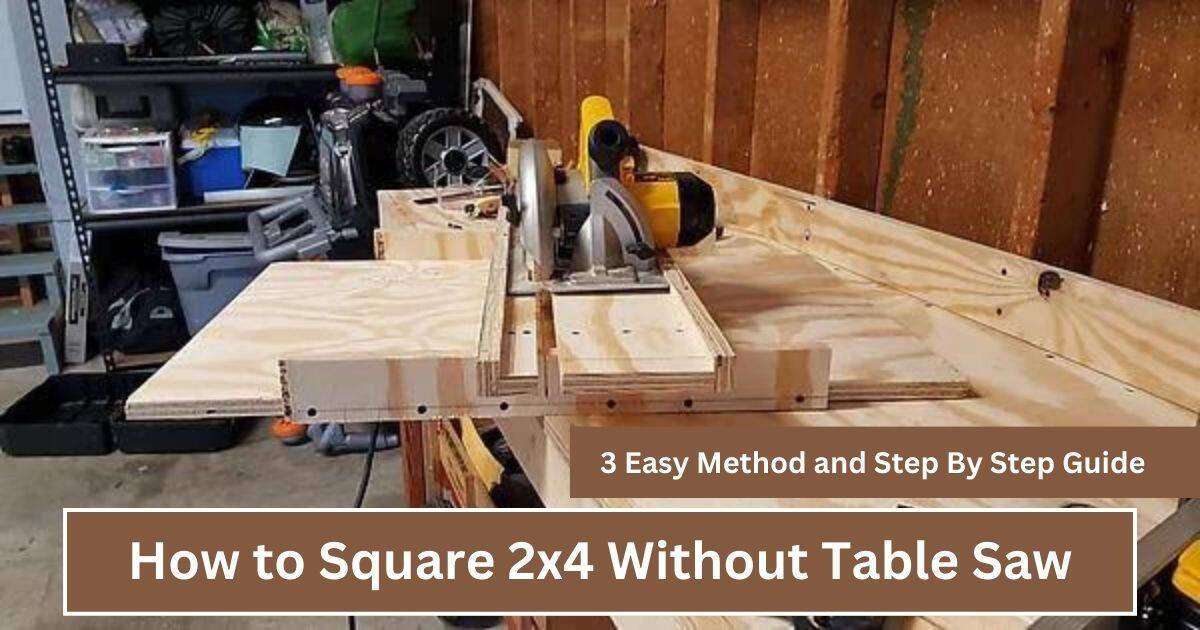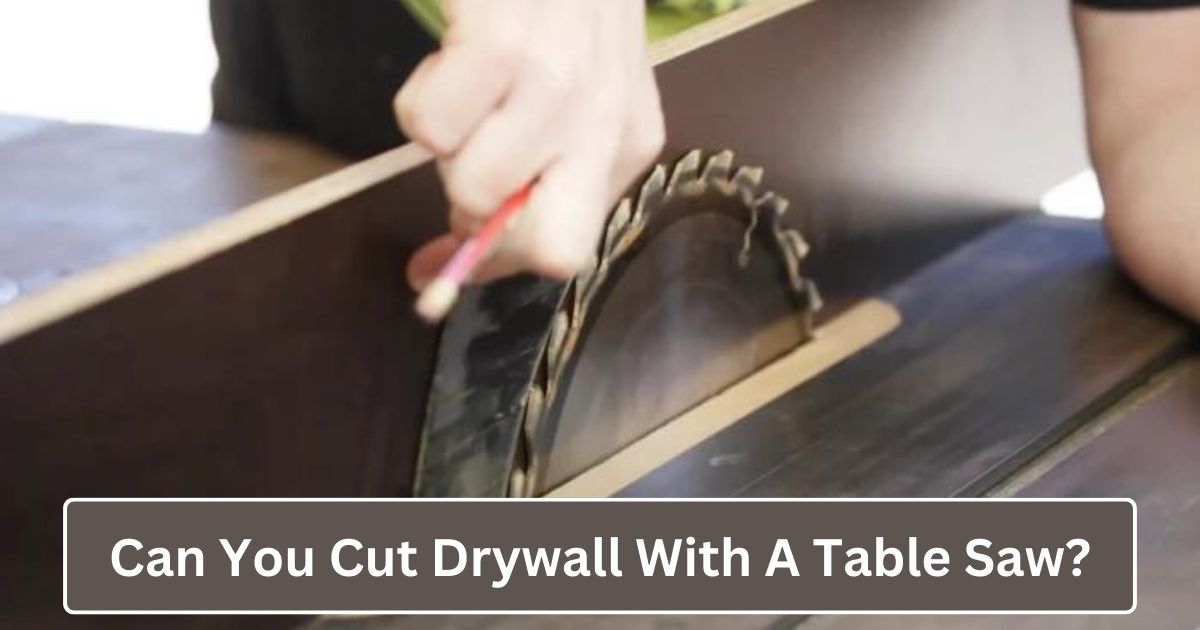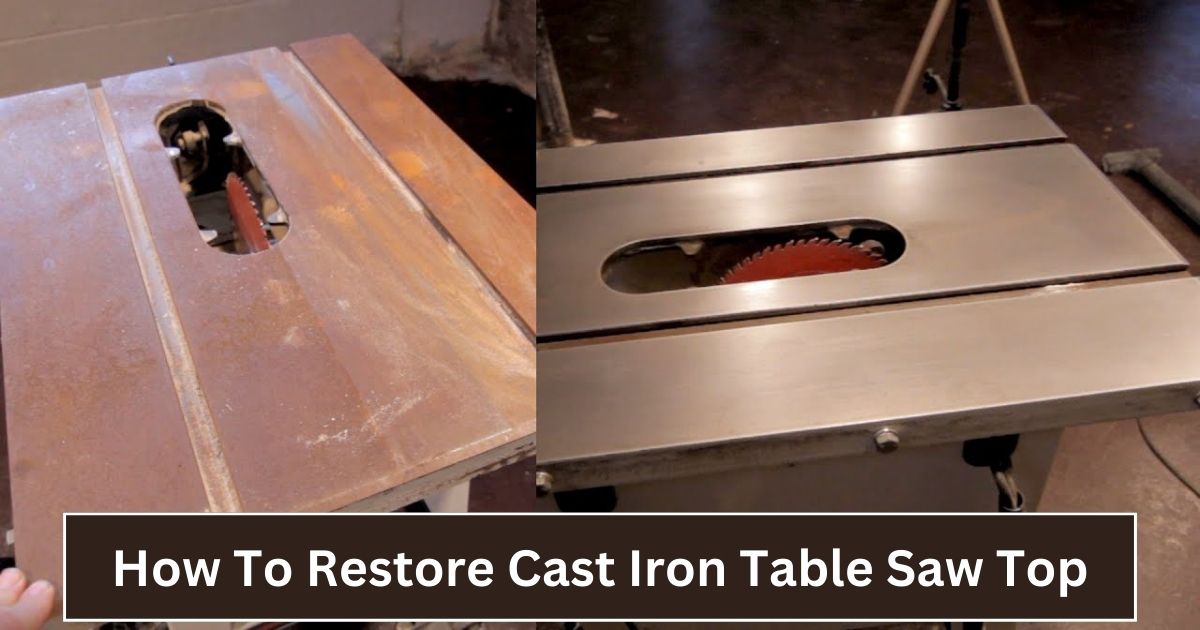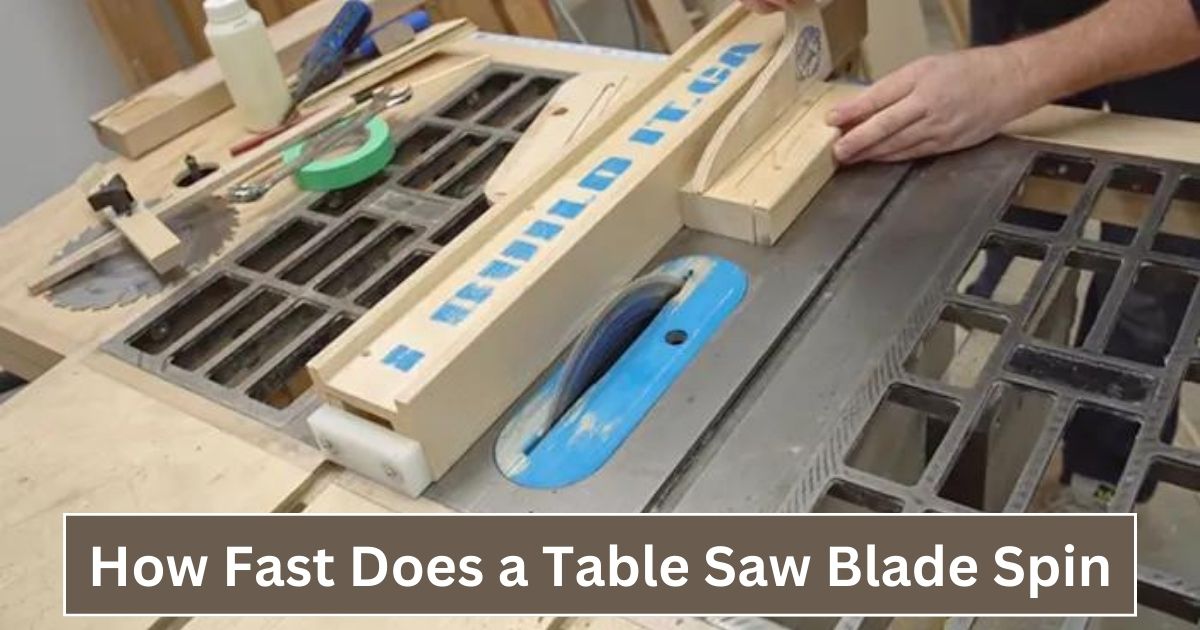Circular saws are important tools for anyone who works with wood professionally or as a hobby. Most of the time, these saws are also used to cut board.
You’ve probably seen a few woodworkers using a circular saw on a table, and you’ve probably decided that you can only use a circular saw on a table. Still, there are times when cutting without a table is necessary. And in those situations, you should know how to use the circular saw without a table correctly.
Safety Precautions: How to Use a Circular Saw Without a Table:
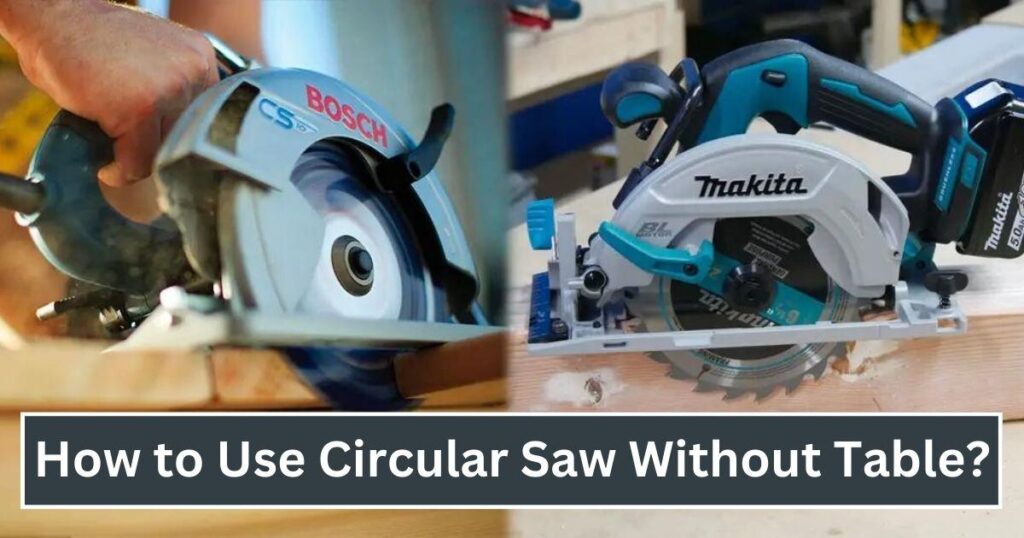
Before starting to use a circular saw without a table, it is important to put safety first. Here are some very important safety tips to remember when using a circular saw:
1)Wear Proper Personal Protective Equipment (PPE):
Always wear the right PPE when using a circular saw to reduce the chance of getting hurt. Important safety gear includes:
- Safety goggles: To keep dust and dirt from getting into your eyes
- Protecting the ears: Ear plugs or earmuffs to protect your ears from the saw’s loud noise
- Gloves: To keep your hands safe from cuts and splinters
- To keep from breathing in sawdust and other particles, wear a dust mask.
2)Check The Saw for Damage and Make Sure it Works:
Before you use the circular saw, check it carefully to make sure it is in good shape. Check for broken or missing parts, make sure the blade is sharp and properly attached, and make sure that safety features, like the blade guard, are working properly.
3)Make Sure Your Area is Clean and Well-lit:
A clean and well-organized work area is important for safety. Get rid of any trash, tools, or other things that could get in the way of your work or cause you to trip. Also, make sure the area is well-lit so you can see your cutting lines and stay away from any dangers.
How to Choose the Best Circular Saw:

To get the best results from your job, you must choose the right circular saw. When picking a circular saw, here are some things to think about:
Circular Saw Types:
There are many different kinds of circular saws, and each has its own pros and cons. There are two main groups:
Corded versus Wireless:
Circular saws with cords are always powered, so they can be used for long amounts of time. But they need to be plugged in and may make it hard to move around. On the other hand, cordless circle saws give you more freedom to move, but their battery life may limit how long you can use them.
Worm drive vs. Sidewinder:
Worm drive saws put the motor behind the blade, which gives them more cutting power and force. Most of the time, these saws are larger and cost more, but they are great for tough jobs. Sidewinder saws have a motor next to the blade, which makes them lighter and smaller. They can be used for general cutting chores and for a long time.
How to Choose the Right Blade:
It’s important to choose the right blade for your job if you want clean, quick cuts. When choosing a blade, think about the following:
Size and Type of Blade:
Circular saw blades come in different sizes, but most of them have a width of between 6 1/2 and 7 1/4 inches. Thicker materials are easier to cut through with bigger blades, while smaller blades are easy to move around. The type of blade should also meet the material you’re cutting, such as wood, metal, or masonry.
Tooth Number and Composition:
How well and quickly a blade cut depends on how many teeth it has. Blades with fewer teeth make cuts faster, but the sides aren’t as smooth. Blades with more teeth make smoother cuts, but they move more slowly.
Also, think about the material of the teeth, like carbide-tipped or high-speed steel, to make sure they will last and cut well.
When choosing a circular saw, it can also be helpful to know how it differs from a reciprocating saw. Circular saws are great for making straight, precise cuts, especially when working with wood.
Reciprocating saws, on the other hand, are better for demolition work, cutting in tight areas, and making rough cuts in different materials. This review can help you figure out which tool will work best for your projects and needs.
Preparing the Content:
Before making a cut with a circular saw, it is necessary to correctly prepare the material. Follow these procedures for precise and safe cutting:
Measure the Cut Line and Mark It:
Mark the cutting line with a pencil or chalk at the length or width you want the cut to be. Use a straight edge, like a carpenter’s square or a level, to draw an exact line along the measured distance for straight cuts.
Use Clamps or a Workbench to Hold the Item in Place:
Use clamps, a table, or sawhorses with built-in clamps to hold the material in place so it doesn’t move while you cut it. Make sure the material is steady and that the part being cut off is well supported to reduce the risk of binding or kickback.
Change the Depth and Angle of the Saw:
Set the depth of your circular saw’s blade so that it sticks out about 1/4 inch below the thickness of the material. This setting makes it less likely that someone will accidentally touch the blade and less likely that it will kick back.
If you need to make a cut at an angle, change the bevel angle on the saw. Before making any changes to the depth or angle of the blade, you should always unplug the saw or take the battery out.
Making the Cut:
After preparing the material and setting up the circular saw, the next step is to make the incision. Follow these instructions for a precise and clean cut:
How to Start the Saw and Set the Blade:
Place the saw so that the blade is just a little bit away from the edge of the cloth. Turn on the saw and let it reach full speed before slowly lowering the blade onto the cut line. Use the saw’s built-in guide notch to line up the blade with the marked line.
Keeping a Constant Cutting Speed:
As you cut, keep the blade of the saw lined up with the cut line and press steadily forward on the saw. Don’t try to force the saw through the material.
If you do, the blade could get stuck or the motor could get too hot. Instead, let the speed of the saw’s blade tell you how fast to move.
Getting Accurate Cuts with a Straight Edge or Guide:
If you want to make sure your cuts are straight and long, you could use a straight edge or a cutting guide. Clamp a straight edge or guide along the line you want to cut, leaving enough room for the saw’s base to move along the edge easily. This setup will help keep the cutting line straight.
Using Plunge Cuts and Forms with a Lot of Angles:
If you need to make a plunge cut or move through a complicated shape, make a small hole or notch at the start of the cut. Lower the blade of the saw carefully into the test hole while keeping the base of the saw flat against the material.
Follow the marked cutting line slowly and carefully, making sure to keep control of the saw. Use a jigsaw or a scroll saw instead if you need to make cuts that are complicated or curved.
How to Cut Cleaner and Safer:
To make cuts with a circular saw that are clean and safe, you need to pay close attention to skill and best practices. Here are some tips that will help you cut better and safer:
Utilizing a Superior Blade:
If you buy a high-quality blade made for the material you’re cutting, the cuts will be cleaner and more effective. A sharp, strong blade makes it less likely that the material will chip or tear, giving it a smooth finish.
Allowing the Saw to Attain Maximum Speed Before Beginning the Cut:
Let the saw blade hit its top speed before putting it into the material. When you start the cut at full speed, you get a clean entry point and less chance of the blade getting caught or stuck.
Permitting the Saw to Completely Halt Before Removing it From the Material:
After you’re done cutting, leave the saw where it is and let go of the trigger. This will stop the blade completely. If you lift the saw before the blade stops moving, you could hurt yourself or damage the material.
Preventing Recoil and Blade Binding:
When the blade gets pinched or stuck in the material, this is called “kickback,” and it makes the saw jerk back toward the user. Make sure the material is well supported and clamped, keep a firm grip on the saw, and if you have a riving knife or another anti-kickback device, use it.
Also, don’t cut with an old or broken blade, and cut slowly and steadily to keep the blade from getting stuck.
Tips for Circular Saw Accuracy When Working Without a Table:
Circular saws are powerful and need a steady hand and good skill to cut with. This makes it hard to cut with accuracy without a circular saw table. If you don’t have a table, here are some tips for cutting straight with a circle saw:
1. Use a Blade that is Sharp:
When a blade is dull, it drags through the material instead of cutting through it. This makes rough edges. It’s best to use a high-quality tooth blade from a well-known brand like DeWALT, DIABLO, Milwaukee, or Makita that has been kept sharp and is right for the job.
2. Use Tape for Masking:
This can help keep some kinds of wood, like plywood or particle board, from splitting. Before you make your cut, put strips of masking tape (like Scotch contractor-grade masking tape) on both sides of where you need to cut so that they cross slightly on either side of the line you want to cut along.
The tape will help keep the fibers in place while you cut. This will give your finished piece cleaner lines and less splintering.
3. Hold the Cutting Board on Both Ends:
To make sure you cut it right, you should hold it up evenly along its length. This means making sure there isn’t a difference in size from one side of your line of cut to the other. If there is, your end product might not be right.
If you can, use clamps or screws to fix your board to a stable surface. This will make cuts more consistent than if you just relied on gravity.
4. Use the Right Blade for Wood that is Wet or Has been Cleaned:
If you are working with wet wood that has preservatives like Creosote or Penta (which are used in fence posts), these chemicals can quickly dull and blunt normal blades.
If this keeps happening, you might want to buy special blades like a DEWALT 20-tooth circular saw blade or a Diablo 40-tooth wet lumber finish circular saw blade. These blades are made for cutting wet wood or wood that has been treated with chemicals.
Circular Saw Safety Tips Without A Table:
It can be dangerous to work with a circular saw without a saw table, but you can make it safer. Here are some safety tips that don’t involve a table:
Check the Plug-in Cord:
Before you use your circular saw, check the power cord to make sure it is in good shape and not damaged or clogged in any way. Check to see if the wire’s insulation is fraying or cracking, and make sure that all of the links are tight. If the power wire is damaged in any way, you should replace it before using the saw.
Stop Cutting if You Smell Something Burning:
When moving, saws make a lot of heat, which can cause things like wood to catch fire if not stopped. If you smell something burning while using your saw, stop using it right away and look for places where heat has been focused for too long.
Make Sure the Teeth of the Saw are Pointing Toward You:
Any kind of circular saw tool needs you to remember that the direction of movement is important for safety. Make sure the teeth on your circle saw are facing you so that you don’t cut against the grain or at an angle that could cause kickback.
Look at the Guard:
Every time you use your saw, check the guard to make sure it’s still in place and working right. The blade guard saves you from splinters and dust that are made when you cut, as well as any kickback that could happen if you don’t use the tool correctly.
Make Sure Your Work is Safe:
If you don’t have a table, you can hold down whatever you’re working on with clamps or another safe way. This will help keep everything still and protect you from kickback if something goes wrong while you’re using your saw.
Personal Protective Equipment (PPE) Should be Worn:
When using power tools like a circular saw without a table, gloves, and other protected clothing that fits the material you’re cutting, always wear the right eye protection.
Bottom Line:
We’ve gone over the most important steps and tips for using a circular saw without a table in this piece. By following these rules, you can make cuts that are clean and accurate while putting safety first. To sum up, don’t forget to:
- Wear safety gear.
- Consider corded vs. cordless and worm drive vs. sidewinder saws when choosing a circular saw and blade for your job.
- Measure, mark, and secure material.
- Cut straight using guidance and proper technique.
- Use a good blade and avoid kickback and blade binding for cleaner, safer cuts.
By practicing and getting good at these techniques, you’ll be able to use a circular saw without a table with confidence for a variety of woodworking jobs.
Take the time to learn how to use your saw and always put safety first to make sure your woodworking projects go well and are fun.
FAQs about How to Use a Circular Saw Without a Table
How do I know when the Blade on my Circular Saw Needs to be Changed?
If your circular saw blade is dull, damaged, or no longer cuts cleanly, replace it. Dull blades make cutting harder, pull out, and burn cut edges. Missing or broken teeth can also signal blade replacement. Sharpening your blade can prolong its life, but a fresh blade will perform better.
Are there any Alternatives to a Circular Saw that can be Used to Make Equivalent Cuts?
Depending on the material and cut, there are alternatives to a circular saw. Table and miter saws make straight wood cuts. For curved or uneven wood, plastic, or thin metal cuts, use a jigsaw.
A track saw cuts straight with little setup time, while a reciprocating saw is good for demolition and tight places. Choose the instrument that fits your project and demands.
How should I Take Care of and Clean a Circular saw?
The right way to clean and keep a circular saw is to check it, clean it, and lubricate it on a regular basis. Before you clean the saw, you should always unplug it or take the battery out. Use a brush or compressed air to get rid of dust and dirt from the saw.
Pay special attention to the motor vents and the blade guard. Use a dry lubricant on moving parts like the blade guard and the part that lets you change the height. Check for loose or broken parts every so often and fix or replace them as needed.
Which Circular Saw is Best for a Beginner?
The best circular saw for a beginner is one that is easy to use, has important safety features, and is a good deal for the money. Look for a saw with a handle that is easy to hold, a motor that works well, and simple depth and bevel changes.
A corded sidewinder saw is often a good choice for beginners because it is lighter, cheaper, and has enough power for most DIY tasks.
Is it Hard to Use a Circular Saw?
It might seem hard to use a circular saw to make straight cuts for your DIY projects, but once you know the basics, these simple tools are easy to use. This guide will teach you how to use a circle saw safely, so you can make straight cuts, crosscuts, and rip cuts with ease and confidence.
How Fast Can a Circle Saw Cut?
Get a 12-amp circle saw if you only need it occasionally and for smaller jobs. If you’re looking for basic performance, on the other hand, you should look for a circular saw with a value of at least 15 amps.
Related Post:
- How Thick is a Table Saw Blade
- Best Table Saw Under 400 Dollars
- Top 9 Best Table Saw Under 1500 Dollars
- Best Table Saw Under 300 Dollars: (Top 10 Picks)
- Can You Cut Plexiglass With a Table Saw?
- How To Sharpen Table Saw Blades
- How to Extend Rip Capacity of Table Saw?
- Can You Cut PVC With a Table Saw?
- Can You Cut Acrylic With A Table Saw?


